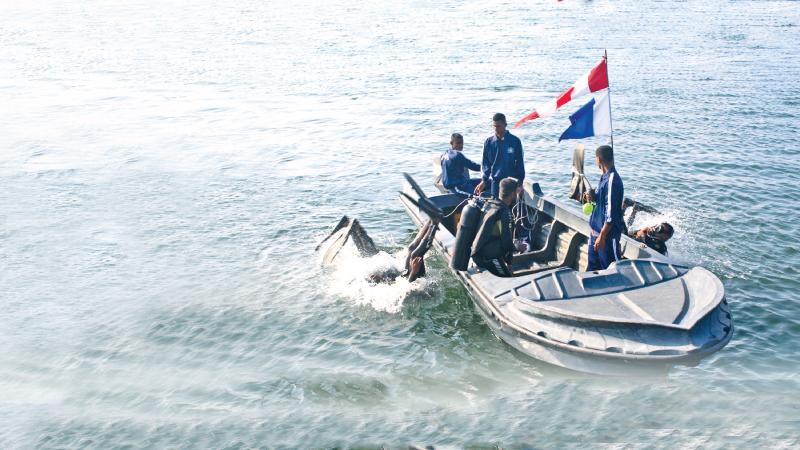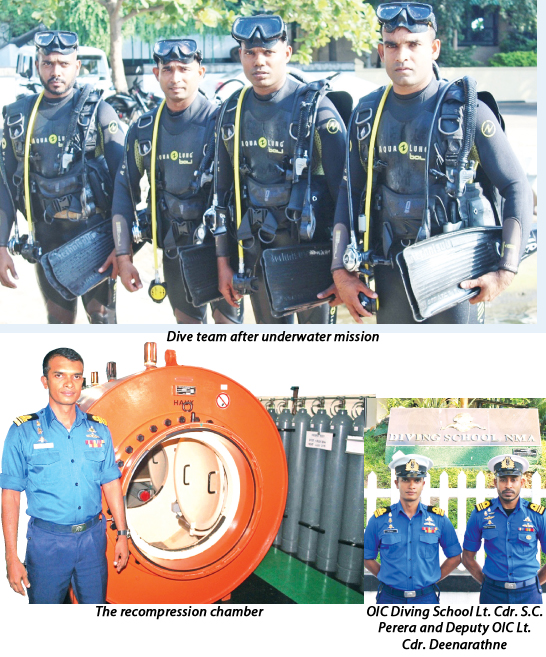
The ocean has captivated us for centuries. It is this quest for exploration which sent mariners sailing across the globe. Yet, beneath the deep blue waters is another whole spectrum of discovery: one that can be witnessed only by calculated diving. Not everyone is able to dive; it takes intense training and remarkable endurance to complete an underwater dive. This is one area in which the men of the Navy display their daring prowess. Civilians dive for pleasure in coral reefs, but the tasks of the navy diver is far superior and laden with greater risk. The Navy Diving School is the only one of its kind in our country and I was privileged to visit this school located at Trincomalee.

Its history dates back to July 1991.The present officer in charge of the school is Lt.Cdr. S.C.Perera, who is assisted by Lt.Cdr. Ashan Deenarathne. These officers explain to me that all prospective sailors who want to undergo diver training must appear for an aptitude test, swimming test and PT test. Priority is placed on swimming. The stages of training are classified as Clearance Diver (CD) 1, 2 and 3. The initial course is carried out for 12 weeks. Just across the school is the vast blue ocean where practical classes take place. Divers are taught about salvage operations, underwater clearance, life saving, recovery of bodies, ship hull inspection (during the period of war the enemy could place limpet mines that stick to the bottom of the ship by magnet), assist in underwater ship repair and combat diving which includes reconnaissance and demolition. The trained diver also has the ability to carry a weapon and shoot from the water.
Each of the 3 stages of learning last 26 weeks. In stages 3 and 2 sailors learn to dive up to 130 feet and in stage 1 they are encouragingly pushed to go up to 180 feet. Every diver must strive to maintain a positive buoyancy. The wet suit, face mask and fins complete the outfit along with the 12.5.Kg oxygen tank which sustains the diver. The ocean has its own natural threat in the form of deadly moray eels and lion fish that deliver a painful bite.
Safety on an assignment is important. Lt.Cdr.Perera insists, “No Buddy- No Dive, we always send a diver with another diver. Each man must look out for the other, as the sea has many hazards. Divers can get entangled in fishing nets and ropes.
The knife is a key part of the sailor’s diving uniform. It can save your life at 180 feet”. We go to the pier where a team is about to ‘cast off’ on a routine task. The dive Petty Officer gives a briefing and the crew boards a small craft.
Another sailor stands by at the pier with the BR2806 an international dive manual which must be kept at all times. Upon reaching their location they hoist the blue and white Alpha flag which is an international visual sign that divers are entering the sea. The 4 divers are ready to slide into the water with another diver on standby. The latter remains on alert to respond to any emergency.
The divers are attached to a lifeline by which they communicate to the dive master. There is a system of pulls and tugs of the rope which sends out signals to the boat. Having completed the search the divers climb aboard and head back to the pier.
All is not over: they have to wash their wet suits in fresh water and also replenish the oxygen tanks. Every diver must take the annual chamber test calibrated to 55 metres.
The conditions at sea are inconsistent and divers can face great danger. Commercial divers are prone to more risks. Lack of oxygen created by various causes can make a diver paralyzed. The Navy has the only recompression chamber in Sri Lanka. This is a complex and unique machine which can treat 10 persons at a time. The orange chamber looks like a large version of the CT scan tube. Installed from Germany in 1987, the chamber has saved many civilian lives by systematically treating them with fresh oxygen. Symptoms of underwater illness include, rash like spots, numb feeling, twitching, nausea and loss of balance. At stage 2, every second counts and the victim must be rushed to the chamber as soon as possible.
The divers have provided a silent service during war and peacetime. They have helped to recover many dead bodies from lakes and rivers. During the aftermath of the 2004 Tsunami they helped in salvage operations to clear the approach way at many harbours. The Navy also trains members of the army, air force and their own SBS teams in diving.
